Coupled Wave-2D Hydrodynamics Modeling at the Reno River Mouth (Italy) under Climate Change Scenarios
Abstract
1. Introduction
2. Description of the Study Area
3. Materials and Methods
3.1. Adopted Methodology and Numerical Modelling Chain
- Wind fields in the Adriatic Sea are obtained every 6 h at 8 km horizontal resolution from the Regional Climate Model (RCM) COSMO-CLM [26], a climate version of the operational weather forecast model COSMO-LM [27]. The simulation generating this dataset [28] encompasses the Italian peninsula and its marine regions, describing the climate evolution under the IPCC RCP8.5 scenario [29,30] in the period 1971–2100. The model is initialized by ERA-Interim Reanalysis [31], and the same model provided boundary conditions for the period 1971–2005, and by the coupled atmosphere-ocean general circulation model CMCC-CM [32] in the period 2006–2100. Compared to previous implementations [33], the validation of the COSMO-CLM wind fields based on in-situ observations along the Italian coast [34] exhibits a particular skill in capturing the wind directional distribution. In turn, results on climatological projections suggest a tendency towards an overall wind energy decrease (in the range of 0–10% across the whole Adriatic Sea), with a stronger decrease along the Bora jets patterns.
- The spectral properties of the sea states in the Adriatic basin are described by means of the phase-averaged wave model SWAN [35] forced by the climatological wind fields from RCM COSMO-CLM [34]. Wave model simulations are carried out under the severe climate change conditions envisaged by the IPCC RCP8.5 scenario in the period 2071–2100 (henceforth referred to as SCE—SCEnarios—dataset) and, for an overall assessment of the model performances, under control conditions in the period 1971–2000 (henceforth referred to as CTR—ConTRol—dataset). The geographical SWAN domain, encompassing the whole Adriatic Sea, is discretized into a curvilinear orthogonal grid with a resolution ranging approximately from nearly 10 km in the southeastern regions to 2 km along the northern Italian coasts. The spectral domain is divided into 25 logarithmically-distributed values between 0.05 and 0.5 Hz and 36 directional sectors. Since the focus of the model is on the northern basin and in the absence of regional wave dataset consistent with the wind forcing, following the same approach described by previous studies [36,37], no waves are prescribed entering the southern boundary, whereas internally-generated energy is allowed to radiate outward.
- The coupled wave-2D hydrodynamics model of the natural beach of Lido di Spina (Figure 1) is implemented by means of the TELEMAC suite [38]. The above-described SWAN results of wave field are extrapolated at the offshore boundary nodes of the detailed mesh performed for TELEMAC runs. The spectral module TOMAWAC (henceforth denoted as TOM [38]) is forced under control and climatological scenarios, and wave-induced currents are taken into account coupling the 2D hydrodynamics module TELEMAC2D (henceforth denoted as TEL2D [39]).
3.2. Past and Projected Future Wave Climate Scenarios
3.2.1. Statistics on Wave Forcings
- the most energetic waves, up to 3.7 m of height, propagate from sectors 50–60° N;
- the most frequent conditions, with wave height up to 1 m, come from 100° N;
- calm sea conditions comprise 20.45% of annual frequency.
3.2.2. Extreme Event Analysis: Joint Probability of Significant Wave Height, Period, and Sea-Level Rise
3.3. Set-up of the Coupled Wave-2D Hydrodynamics Numerical Model
4. Results and Discussion
4.1. Wave and Hydrodynamics
4.2. Inundated Areas
- In the northern area, the channel outlet is subject to a general increment of flooded area extension in all the simulated scenarios and despite the absence of river discharges, revealing the high vulnerability of these flood prone areas to climate changes.
- The natural beach of Lido di Spina seems not to be significantly inundated in case of ordinary events both from Sirocco and Bora, as well as in future scenarios as resulted after SCE runs; the area, instead, is much more strongly threatened by the predicted future sea-level rise in case of extreme events (Figure 13 and Figure 14, right panels).
- The older outlet of Bellocchio channel seems not to be particularly affected in terms of inundated area by climate change scenarios under extreme conditions (TR = 25 years), both for Sirocco and Bora events (Figure 13 and Figure 14, right panels). While in case of ordinary event generated by Bora wind (Figure 14, left panel), and already for conditions typical of the CTR scenario, the area experiences a sea inundation that significantly increases in SCE scenario; sea-level rise is also responsible of a significant increase in the flooded area extension also in case of ordinary event generated by Sirocco event (Figure 13, left panel).
4.3. Discussion of the Effects of Expected Climate Changes
- Variation of the wave breaking line position ΔxB (m) calculated asin which xB,SCE and xB,CTR are the breaking line positions for SCE and CTR runs, respectively. This data would allow estimating wave energy in the surf zone and impacting the shoreline.ΔxB = xB, SCE − xB, CTR
- Changes in the maximum alongshore currents calculated ΔUls, MAX (%) asin which Uls, MAX SCE and Uls, MAX CTR are the maximum alongshore velocity computed in SCE and CTR runs, respectively. This value could give evidence of the estimated variation induced by climate changes in morphological patterns driving the inter-annual area evolution.ΔUls, MAX = (Uls, MAX SCE − Uls, MAX CTR)/Uls, MAX CTR × 100
- The computed percentage of inundated area variation ΔΩ (-) is calculated asin which ΩSCE and ΩCTR are the estimated inundated areas for SCE and CTR runs, respectively; this information could help in evaluating the flooding hazard increment connected to climate changes.ΔΩ =(ΩSCE − ΩCTR)/ΩCTR
5. Conclusions
Author Contributions
Funding
Acknowledgments
Conflicts of Interest
References
- Androulidakis, Y.S.; Kombiadou, K.D.; Makris, C.V.; Baltikas, V.N.; Krestenitis, Y.N. Storm surges in the Mediterranean Sea: Variability and trends under future climatic condition. Dyn. Atmos. Ocean. 2015, 71, 56–82. [Google Scholar] [CrossRef]
- Lionello, P.; Conte, D.; Marzo, L.; Scarascia, L. The contrasting effect of increasing mean sea level and decreasing storminess on the maximum water level during storms along the coast of the Mediterranean Sea in the mid 21st century. Glob. Planet. Chang. 2017, 151, 80–91. [Google Scholar] [CrossRef]
- Carisi, F.; Domeneghetti, A.; Gaeta, M.G.; Castellarin, A. Is anthropogenic land-subsidence a possible driver of riverine flood-hazard dynamics? A case study in Ravenna, Italy. Hydrol. Sci. J. 2017, 62, 1–16. [Google Scholar] [CrossRef]
- Bonaldo, D.; Antonioli, F.; Archetti, R.; Bezzi, A.; Correggiari, A.; Davolio, S.; de Falco, G.; Fantini, M.; Fontolan, G.; Furlani, S.; et al. Integrating multidisciplinary instruments for assessing coastal vulnerability to erosion and sea level rise: Lessons and challenges from the Adriatic Sea, Italy. J. Coast. Conserv. 2018, 22, 1–19. [Google Scholar] [CrossRef]
- Samaras, A.G.; Koutitas, C.G. Modeling the impact of climate change on sediment transport and morphology in coupled watershed-coast systems: A case study using an integrated approach. Int. J. Sediment Res. 2014, 29, 304–315. [Google Scholar] [CrossRef]
- Tsoukala, V.K.; Chondros, T.M.; Kapelonis, Z.G.; Martzikos, N.; Lykou, A.; Belibassakis, K.; Makropoulos, C. An integrated wave modelling framework for extreme and rare events for climate change in coastal areas—The case of Rethymno, Crete. Oceanologia 2016, 58, 71–89. [Google Scholar] [CrossRef]
- Lambeck, K.; Antonioli, F.; Anzidei, M.; Ferranti, L.; Leoni, G.; Scicchitano, G.; Silenzi, S. Sea level change along the Italian coast during the Holocene and projections for the future. Quat. Int. 2011, 232, 250–257. [Google Scholar] [CrossRef]
- Antonioli, F.; Anzidei, M.; Amorosi, A.; Presti, V.L.; Mastronuzzi, G.; Deiana, G.; De Falco, G.; Fontana, A.; Fontolan, G.; Lisco, S.; et al. Sea-level rise and potential drowning of the Italian coastal plains: Flooding risk scenarios for 2100. Quat. Sci. Rev. 2017, 158, 29–43. [Google Scholar] [CrossRef]
- Perini, L.; Calabrese, L.; Luciani, P.; Olivieri, M.; Galassi, G.; Spada, G. Sea-level rise along the Emilia-Romagna coast (Northern Italy) in 2100: Scenarios and impacts. Nat. Hazards Earth Syst. Sci. 2017, 17, 2271–2287. [Google Scholar] [CrossRef]
- Perini, L.; Calabrese, L.; Salerno, G.; Ciavola, P.; Armaroli, C. Evaluation of coastal vulnerability to flooding: Comparison of two different methodologies adopted by the Emilia-Romagna region (Italy). Nat. Hazards Earth Syst. Sci. 2016, 16, 181–194. [Google Scholar] [CrossRef]
- Di Risio, M.; Bruschi, A.; Lisi, I.; Pesarino, V.; Pasquali, D. Comparative analysis of coastal flooding vulnerability and hazard assessment at national scale. J. Mar. Sci. Eng. 2017, 5, 51. [Google Scholar] [CrossRef]
- Seenath, A.; Wilson, M.; Miller, K. Hydrodynamic versus GIS modelling for coastal flood vulnerability assessment: Which is better for guiding coastal management? Ocean Coast. Manag. 2016, 120, 99–109. [Google Scholar] [CrossRef]
- Carniel, S.; Warner, J.C.; Chiggiato, J.; Sclavo, M. Investigating the impact of surface wave breaking on modelling the trajectories of drifters in the Northern Adriatic Sea during a wind-storm event. Ocean Model. 2009, 30, 225–239. [Google Scholar] [CrossRef]
- Boldrin, A.; Carniel, S.; Giani, M.; Marini, M.; Bernardi Aubry, F.; Campanelli, A.; Grilli, F.; Russo, A. The effect of Bora wind on physical and bio-chemical properties of stratified waters in the Northern Adriatic. J. Geophys. Res. 2009, 114, C08S92. [Google Scholar] [CrossRef]
- Carniel, S.; Sclavo, M.; Archetti, R. Towards validating a last generation, integrated wave-current-sediment numerical model in coastal regions using video measurements. Ocean. Hydrobiol. Stud. 2011, 40, 11–20. [Google Scholar] [CrossRef]
- Archetti, R.; Zanuttigh, B. Integrated monitoring of the hydro-morphodynamics of a beach protected by low crested detached breakwaters. Coast. Eng. 2010, 57, 879–891. [Google Scholar] [CrossRef]
- Stocker, T.F.; Qin, D.; Plattner, G.-K.; Tignor, M.; Allen, S.K.; Boschung, J.; Nauels, A.; Xia, Y.; Bex, V.; Midgley, P.M. Summary for policy makers. In Climate Change 2013: The Physical Science Basis; Cambridge University Press: Cambridge, UK, 2013; pp. 3–29. [Google Scholar]
- Villatoro, M.; Silva, R.; Méndez, F.J.; Zanuttigh, B.; Pan, S.; Trifonova, E.; Losada, I.J.; Izaguirre, C.; Simmonds, D.; Reeve, D.E.; et al. An approach to assess flooding and erosion risk for open beaches in a changing climate. Coast. Eng. 2014, 87, 50–76. [Google Scholar] [CrossRef]
- Sanuy, M.; Duo, E.; Jäger, W.S.; Ciavola, P.; Jiménez, J.A. Linking source with consequences of coastal storm impacts for climate change and risk reduction scenarios for Mediterranean sandy beaches. Nat. Hazards Earth Syst. Sci. 2018, 18, 1825–1847. [Google Scholar] [CrossRef]
- Artegiani, A.; Barale, V.; Cushman-Roisin, B.; Gačić, M.; Kourafalou, V.H.; Lascaratos, A.; Malačić, V.; Manca, B.B.; Mantziafou, A.; Orlić, M.; et al. Northern Adriatic Sea. In Physical Oceanography of the Adriatic Sea Past, Present and Future; Cushman-Roisin, B., Gačić, M., Poulain, P.M., Artegiani, A., Eds.; Kluwer Academic Publishers: Dordrecht, The Netherlands, 2001; pp. 143–165. [Google Scholar]
- Lionello, P.; Cavaleri, L.; Nissen, K.M.; Pino, C.; Raicich, F.; Ulbrich, U. Severe marine storms in the Northern Adriatic: Characteristics and trends. Phys. Chem. Earth Parts A/B/C 2012, 40–41, 93–105. [Google Scholar] [CrossRef]
- Aguzzi, M.; Bonsignore, F.; De Nigris, N.; Morelli, M.; Paccagnella, T.; Romagnoli, C.; Unguendoli, S. Stato Del Litorale Emiliano—Romagnolo Al 2012. Erosione e Interventi di Difesa, Quaderni di ARPAE—Regione Emilia Romagna; Arpae Emilia-Romagna: Bologna, Italy, 2012; ISBN 978-88-87854-41-1. (In Italian) [Google Scholar]
- Martinelli, L.; Zanuttigh, B.; Corbau, C. Assessment of coastal flooding hazard along the Emilia Romagna Littoral, IT. Coast. Eng. 2010, 57, 1042–1158. [Google Scholar] [CrossRef]
- Archetti, R.; Gaeta, M.G. Design of multipurpose coastal protection measures at the Reno river mouth (Italy). In Proceedings of the 28th International Ocean and Polar Engineering Conference, Sapporo, Japan, 10–15 June 2018; pp. 1343–1348. [Google Scholar]
- Google Earth (Image ©2017 TerraMetrics, Data SIO, NOAA, U.S. Navy, NGA, GEBCO, 2017). Available online: https://www.google.com/earth/ (accessed on 5 April 2018).
- Rockel, B.; Will, A.; Hense, A. The regional Climate Model COSMO-CLM (CCLM). Meteorol. Z. 2008, 17, 347–348. [Google Scholar] [CrossRef]
- Steppeler, J.; Doms, G.; Schattler, U.; Bitzer, H.W.; Gassmann, A.; Damrath, U.; Gregoric, G. Meso-gamma scale forecasts using the nonhydrostatic model LM. Meteorol. Atmos. Phys. 2003, 82, 75–96. [Google Scholar] [CrossRef]
- Bucchignani, E.; Montesarchio, M.; Zollo, A.L.; Mercogliano, P. High-resolution climate simulations with COSMO-CLM over Italy: Performance evaluation and climate projections for the 21st century. Int. J. Climatol. 2016, 36, 735–756. [Google Scholar] [CrossRef]
- Moss, R.; Edmons, J.; Hibbard, K.; Manning, M.; Rose, S.; van Vuuren, D.P.; Carter, T.; Emori, S.; Kainuma, M.; Kram, T.; et al. The next generation of scenarios for climate change research and assessment. Nature 2010, 463, 747–756. [Google Scholar] [CrossRef] [PubMed]
- Church, J.A.; Clark, P.U.; Cazenave, A.; Gregory, J.M.; Jevrejeva, S.; Levermann, A.; Merrifield, M.A.; Milne, G.A.; Nerem, R.S.; Nunn, P.D.; et al. Sea level change. In Climate Change 2013: The Physical Science Basis. Contribution of Working Group I to the Fifth Assessment Report of the Intergovernmental Panel on Climate Change; Cambridge University Press: Cambridge, UK; New York, NY, USA, 2013. [Google Scholar]
- Dee, D.; Uppala, S.; Simmons, A.; Berrisford, P.; Poli, P.; Kobayashi, S.; Andrae, U.; Balmaseda, M.; Balsamo, G.; Bauer, P.; et al. The era-interim reanalysis: Configuration and performance of the data assimilation system. Q. J. R. Meteorol. Soc. 2011, 137, 553–597. [Google Scholar] [CrossRef]
- Scoccimarro, E.; Gualdi, S.; Bellucci, A.; Sanna, A.; Fogli, P.; Manzini, E.; Vichi, M.; Oddo, P.; Navarra, A. Effects of tropical cyclones on ocean heat transport in a high resolution coupled general circulation model. J. Clim. 2011, 24, 4368–4384. [Google Scholar] [CrossRef]
- Bellafiore, D.; Bucchignani, E.; Gualdi, S.; Carniel, S.; Djurdjevic, V.; Umgiesser, G. Assessment of meteorological climate models as inputs for coastal studies. Ocean Dyn. 2012, 62, 555–568. [Google Scholar] [CrossRef]
- Bonaldo, D.; Bucchignani, E.M.; Ricchi, A.; Carniel, S. Wind storminess in the Adriatic Sea in a climate change scenario. Acta Adriat. 2017, 58, 195–208. [Google Scholar]
- Booij, N.; Ris, R.C.; Holthuijsen, L.H. A third-generation wave model for coastal regions: 1. Model description and validation. J. Geophys. Res. 1999, 104, 7649–7666. [Google Scholar] [CrossRef]
- Benetazzo, A.; Fedele, F.; Carniel, S.; Ricchi, A.; Bucchignani, E.; Sclavo, M. Wave climate of the Adriatic Sea: A future scenario simulation. Nat. Hazards Earth Syst. Sci. 2012, 12, 2065–2076. [Google Scholar] [CrossRef]
- Benetazzo, A.; Bergamasco, A.; Bonaldo, D.; Falcieri, F.M.; Sclavo, M.; Langone, L.; Carniel, S. Response of the Adriatic Sea to an intense cold air outbreak: Dense water dynamics and wave-induced transport. Prog. Oceanogr. 2014, 128, 115–138. [Google Scholar] [CrossRef]
- Benoit, M.; Marcos, F.; Becq, F. Development of a third generation shallow-water wave model with unstructured spatial meshing. In Proceedings of the 25th International Conference on Coastal Engineering, Orlando, FL, USA, 2–6 September 1996. [Google Scholar]
- Hervouet, J.M. Hydrodynamics of Free Surface Flows: Modelling with the Finite Element Method; John Wiley & Sons, Ltd.: London, UK, 2007; p. 360. [Google Scholar]
- Masina, M.; Lamberti, A.; Archetti, R. Coastal flooding: A copula based approach for estimating the joint probability of water levels and waves. Coast. Eng. 2015, 97, 37–52. [Google Scholar] [CrossRef]
- Boccotti, P. Wave Mechanics for Ocean Engineering; Elsevier: New York, NY, USA, 2000. [Google Scholar]
- Husler, J.; Reiss, R.-D. Maxima of normal random vectors: Between independence and complete dependence. Stat. Probab. Lett. 1989, 7, 283–286. [Google Scholar] [CrossRef]
- Conte, D.; Lionello, P. Characteristics of large positive and negative surges in the Mediterranean Sea and their attenuation in future climate scenarios. Glob. Planet. Chang. 2013, 111, 159–173. [Google Scholar] [CrossRef]
- Vousdoukas, M.I.; Voukouvalas, E.; Annunziato, A.; Giardino, A.; Feyen, L. Projections of extreme storm surge levels along Europe. Clim. Dyn. 2016, 47, 3171–3190. [Google Scholar] [CrossRef]
- Rahmstorf, S. A semi-empirical approach to projecting future sea-level rise. Science 2007, 315, 368–370. [Google Scholar] [CrossRef] [PubMed]
- Cavaleri, L.; Abdalla, S.; Benetazzo, A.; Bertotti, L.; Bidlot, J.-R.; Breivik, Ø.; Carniel, S.; Jensen, R.E.; Portilla-Yandun, J.; Rogers, W.E.; et al. Wave modelling in coastal and inner seas. Prog. Oceanogr. 2018. [Google Scholar] [CrossRef]
- TELEMAC. The Mathematically Superior Suite of Solvers 2017. Available online: http://www.opentelemac.com (accessed on 10 April 2018).
- Kuang, C.P.; Stansby, P. Modelling directional random wave propagation inshore. Proc. Inst. Civ. Eng. Marit. Eng. 2004, 157, 123–131. [Google Scholar] [CrossRef]
- Hervouet, J.-M.; Razafindrakoto, E.; Villaret, C. Dealing with dry zones in free surface flows: A new class of advection schemes. In Proceedings of the 34th IAHR World Congress, Brisbane, Australia, 26 June–1 July 2011. [Google Scholar]
- Villaret, C.; Hervouet, J.-M.; Kopmann, R.; Merkel, U.; Davies, A. Morphodynamic modeling using the Telemac finite-element system. Comput. Geosci. 2013, 53, 105–113. [Google Scholar] [CrossRef]
- Longuet-Higgins, M.S.; Stewart, R.W. Radiation stresses in water waves; a physical discussion, with applications. Deep Sea Res. Oceanogr. Abstr. 1964, 11, 529–562. [Google Scholar] [CrossRef]
- CHC—Canadian Hydraulics Centre, National Research Council. Blue Kenue. Reference Manual; Canadian Hydraulics Centre, National Research Council: Ottawa, ON, Canada, 2010.
- Samaras, A.G.; Gaeta, M.G.; Miquel, A.M.; Archetti, R. High-resolution wave and hydrodynamics modelling in coastal areas: Operational applications for coastal planning, decision support and assessment. Nat. Hazards Earth Syst. Sci. 2016, 16, 1499–1518. [Google Scholar] [CrossRef]
- Gaeta, M.G.; Samaras, A.G.; Federico, I.; Archetti, R.; Maicu, F.; Lorenzetti, G. A coupled wave-3D hydro-dynamics model of the Taranto Sea (Italy): A multiple-nesting approach. Nat. Hazards Earth Syst. Sci. 2016, 16, 2071–2083. [Google Scholar] [CrossRef]
- Battjes, J.A.; Janssen, J.P.F.M. Energy loss and set-up due to breaking of random waves. In Proceedings of the 16th International Conference on Coastal Engineering, Hamburg, Germany, 27 August–3 September 1978; pp. 569–587. [Google Scholar]
- Hasselmann, K.; Barnett, T.P.; Bouws, E.; Carlson, H.; Cartwright, D.E.; Enke, K.; Ewing, J.A.; Gienapp, H.; Hasselmann, D.E.; Kruseman, P.; et al. Measurements of wind-wave growth and swell decay during the Joint North Sea Wave Project (JONSWAP). Ergänz. Dtsch. Hydrogr. Z. Reihe 1973, A 8, 95. [Google Scholar]
- Eldeberky, Y.; Battjes, J.A. Parameterisation of triads interactions in wave energy models. In Proceedings of the Coastal Dynamics Conference ’95, Gdansk, Poland, 4–8 September 1995; pp. 140–148. [Google Scholar]
- Ruessink, B.; Miles, J.; Feddersen, F.; Guza, R.; Elgar, S. Modeling the alongshore current on barred beaches. J. Geophys. Res. 2001, 106, 22451–22463. [Google Scholar] [CrossRef]
- Feddersen, F.; Guza, R. Observation of nearshore circulation: Alongshore uniformity. J. Geophys. Res. 2003, 108, 6-1–6-10. [Google Scholar] [CrossRef]
- Sclavo, M.; Benetazzo, A.; Carniel, S.; Bergamasco, A.; Falcieri, F.M.; Bonaldo, D. Wave-current interaction effect on sediment dispersal in a shallow semi-enclosed basin. J. Coast. Res. 2013, 65, 1587–1592. [Google Scholar] [CrossRef]
- Carniel, S.; Bonaldo, D.; Benetazzo, A.; Bergamasco, A.; Boldrin, A.; Falcieri, F.M.; Sclavo, M.; Trincardi, F.; Langone, L. Off-shelf fluxes across the southern Adriatic margin: Factors controlling dense-water-driven transport phenomena. Mar. Geol. 2016, 375, 44–63. [Google Scholar] [CrossRef]
- Archetti, R. Quantifying the evolution of a beach protected by low crested structures using video monitoring. J. Coast. Res. 2009, 25, 884–899. [Google Scholar] [CrossRef]
- Bonaldo, D.; Benetazzo, A.; Sclavo, M.; Carniel, S. Modelling wave-driven sediment transport in a changing climate: A case study for northern Adriatic Sea (Italy). Reg. Environ. Chang. 2015, 15, 45–55. [Google Scholar] [CrossRef]
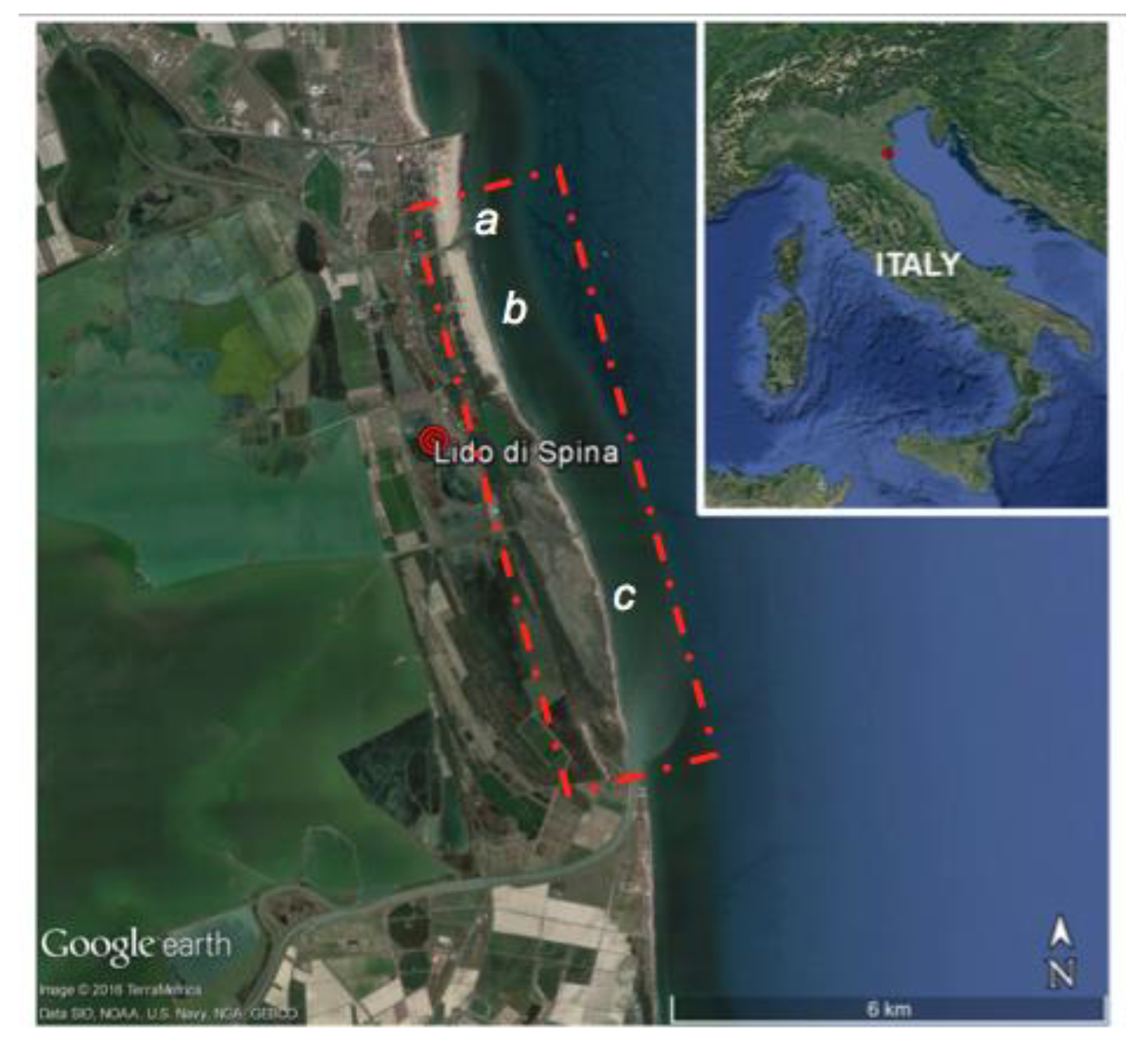
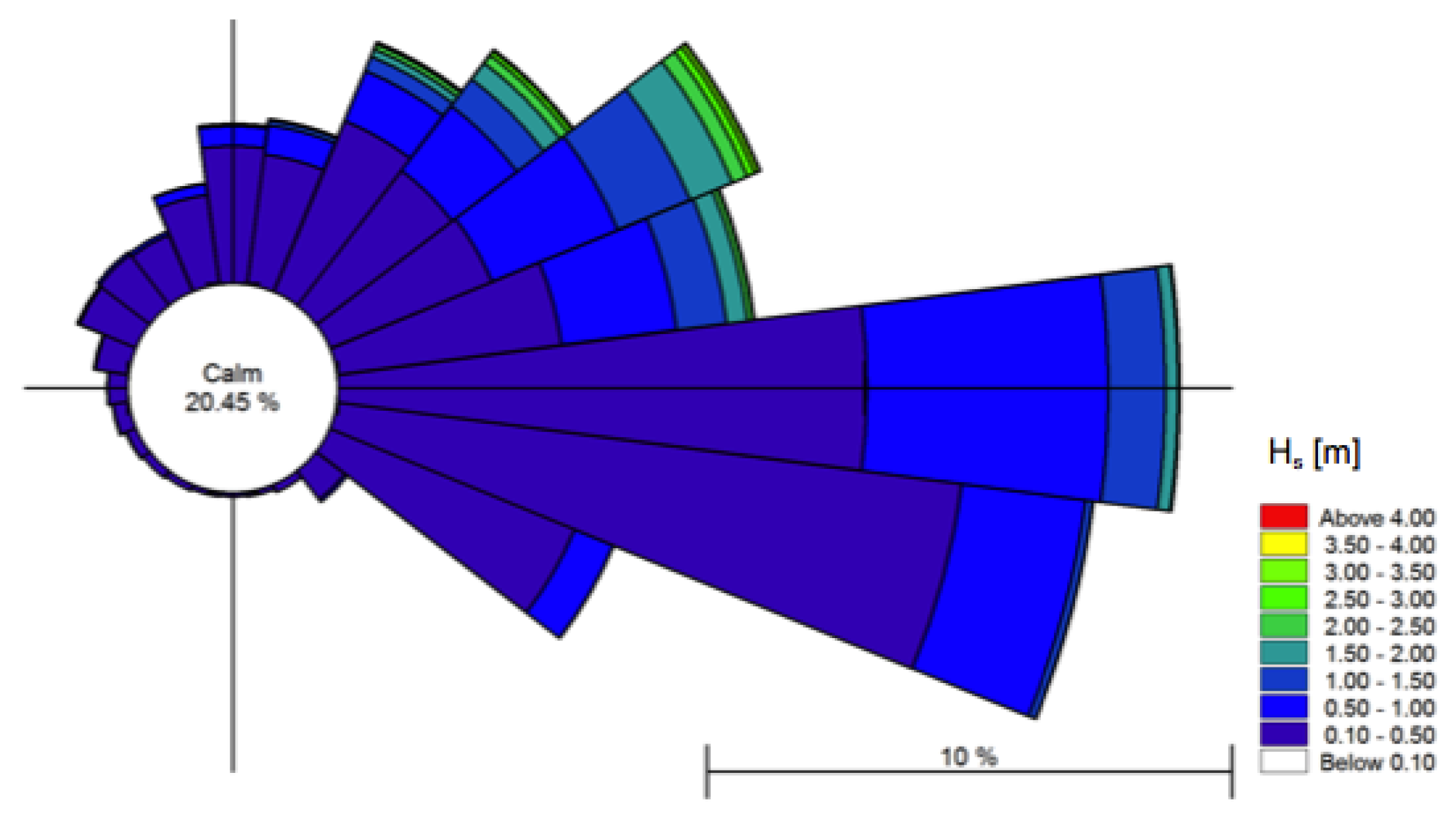
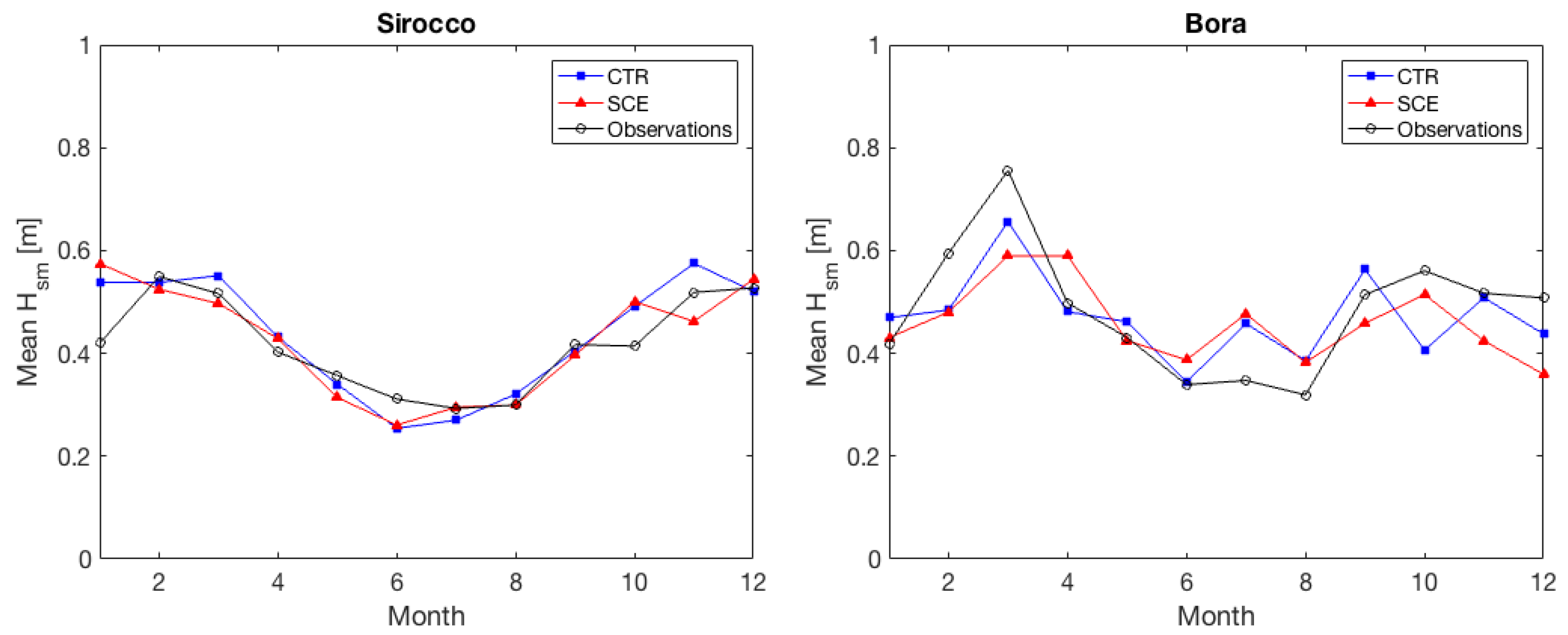
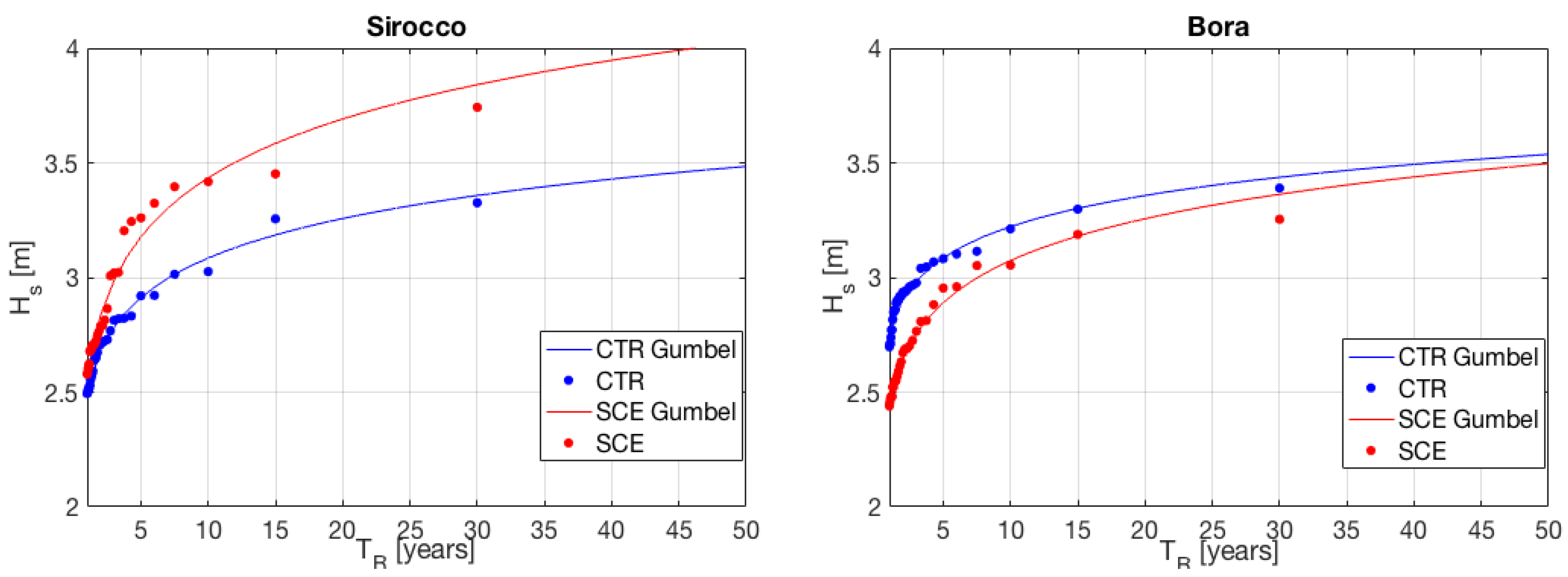
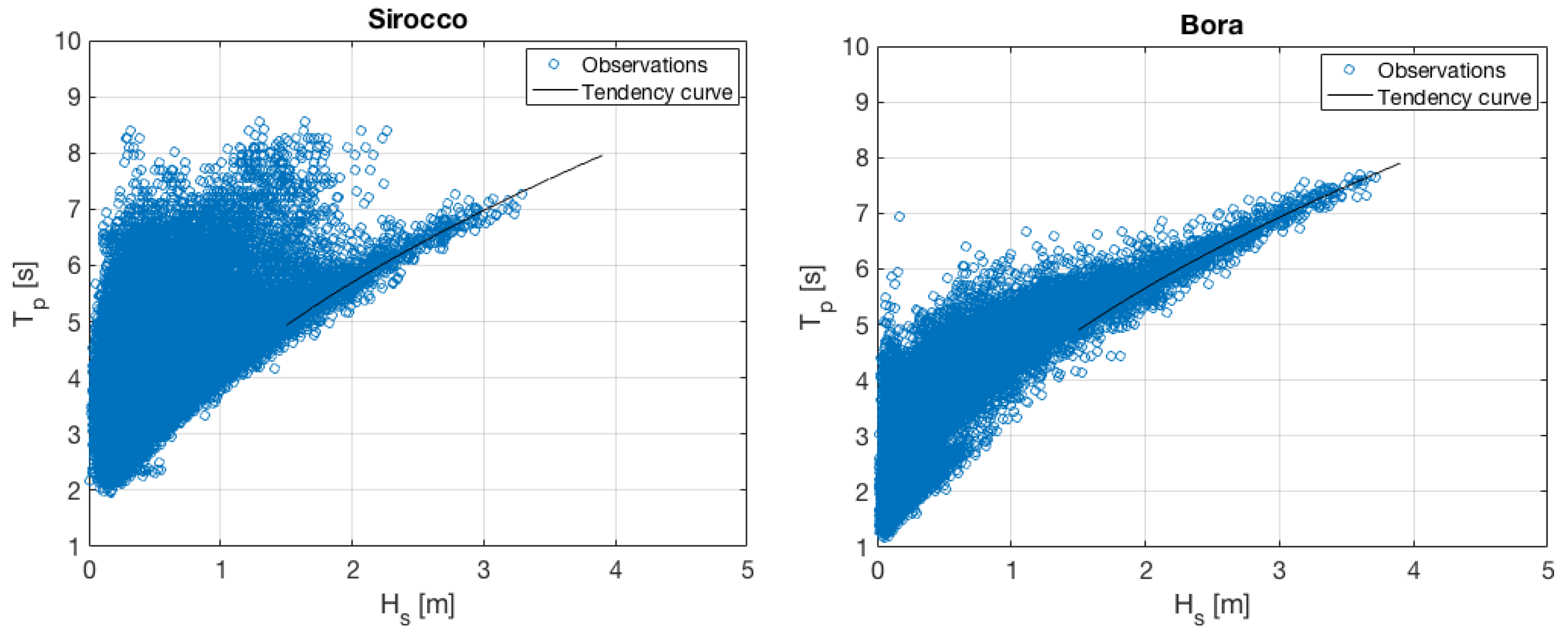
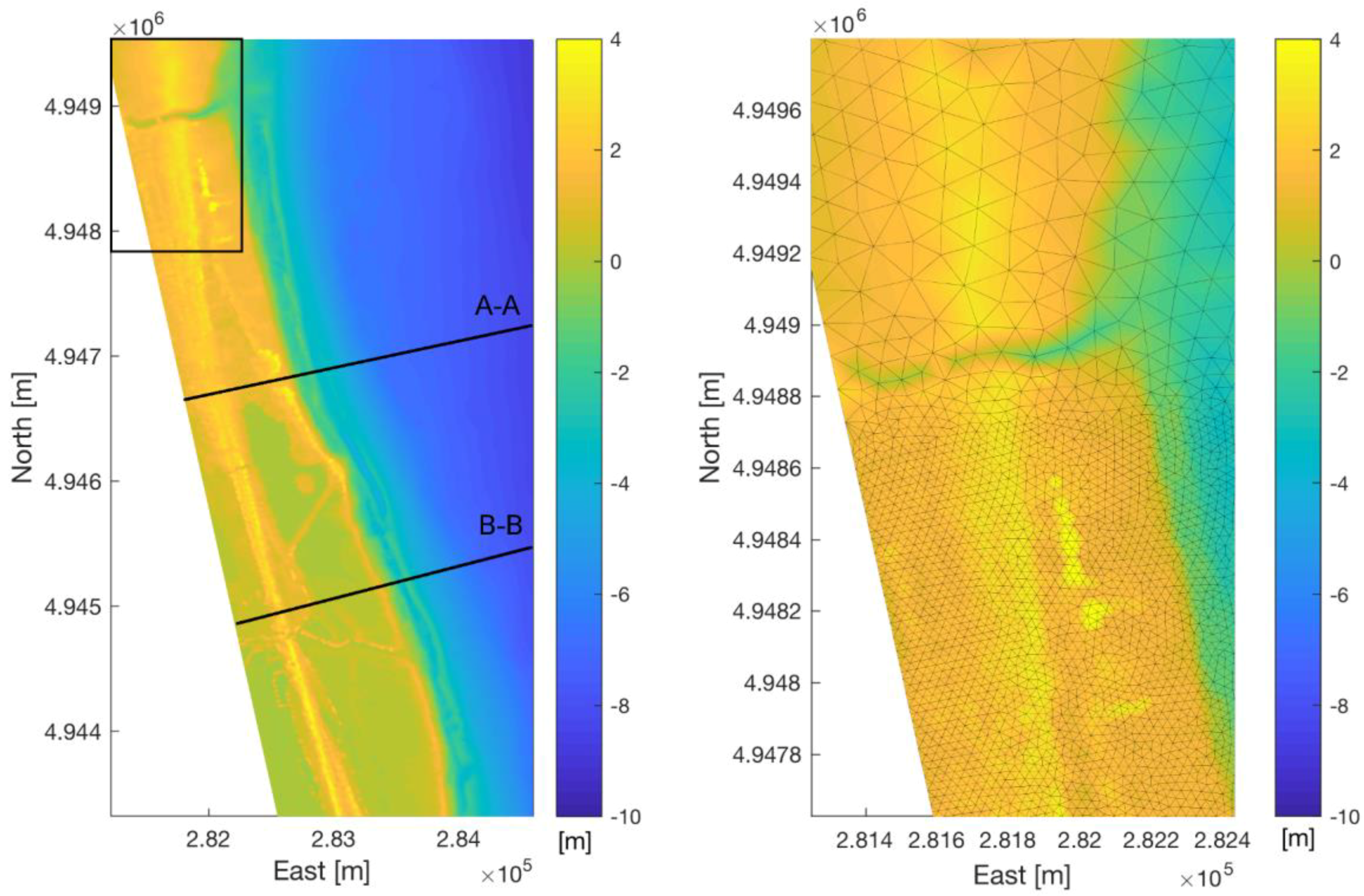
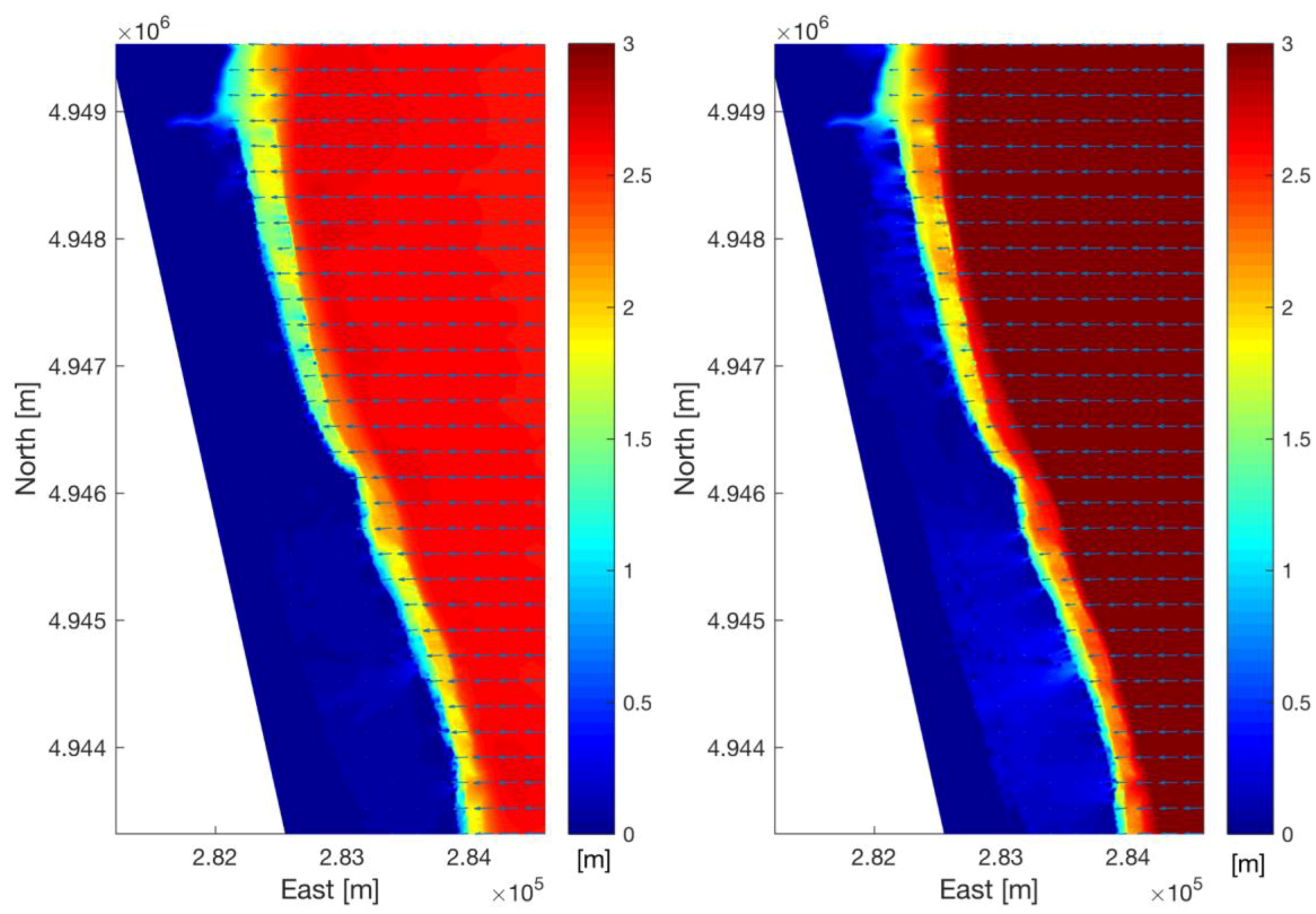
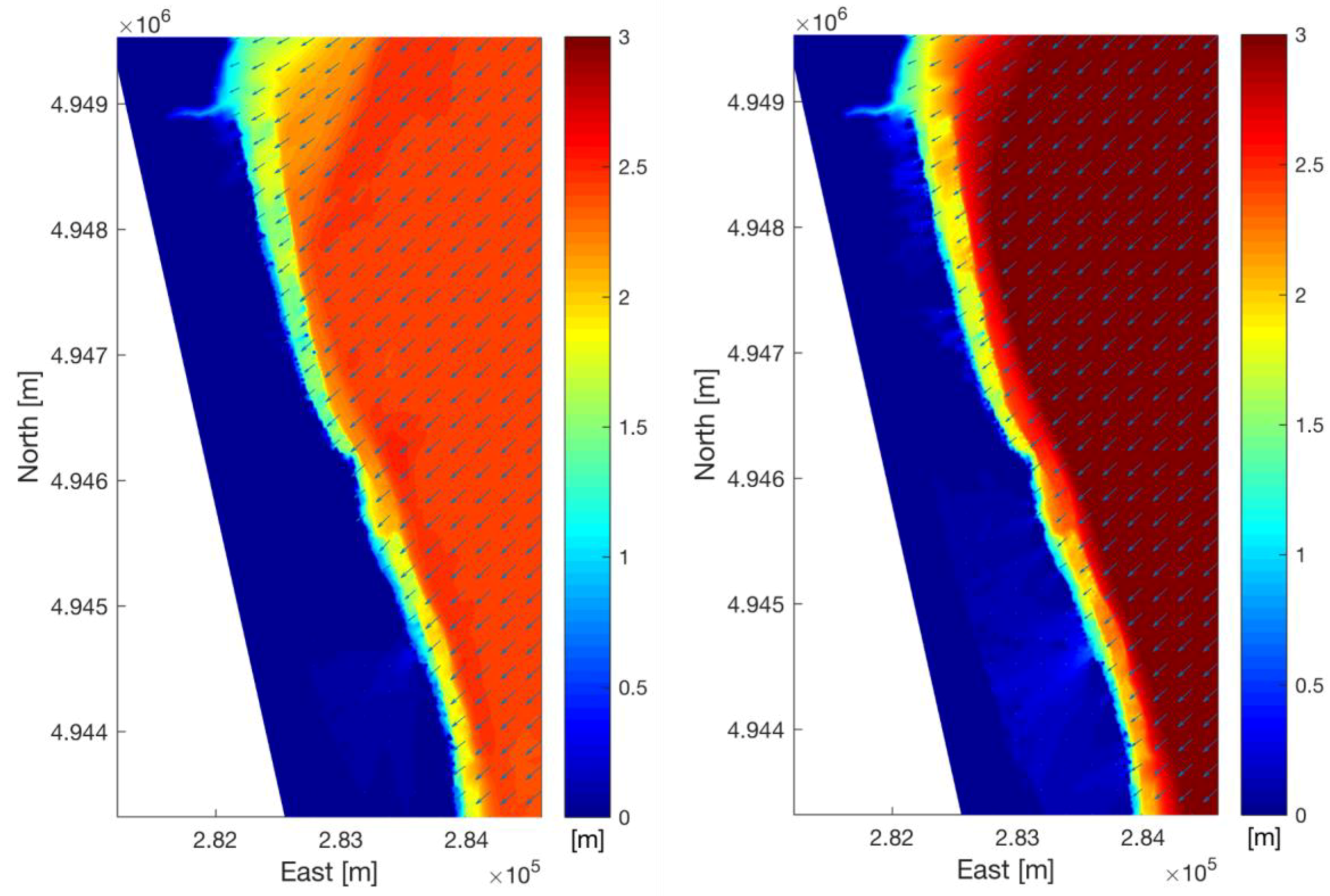
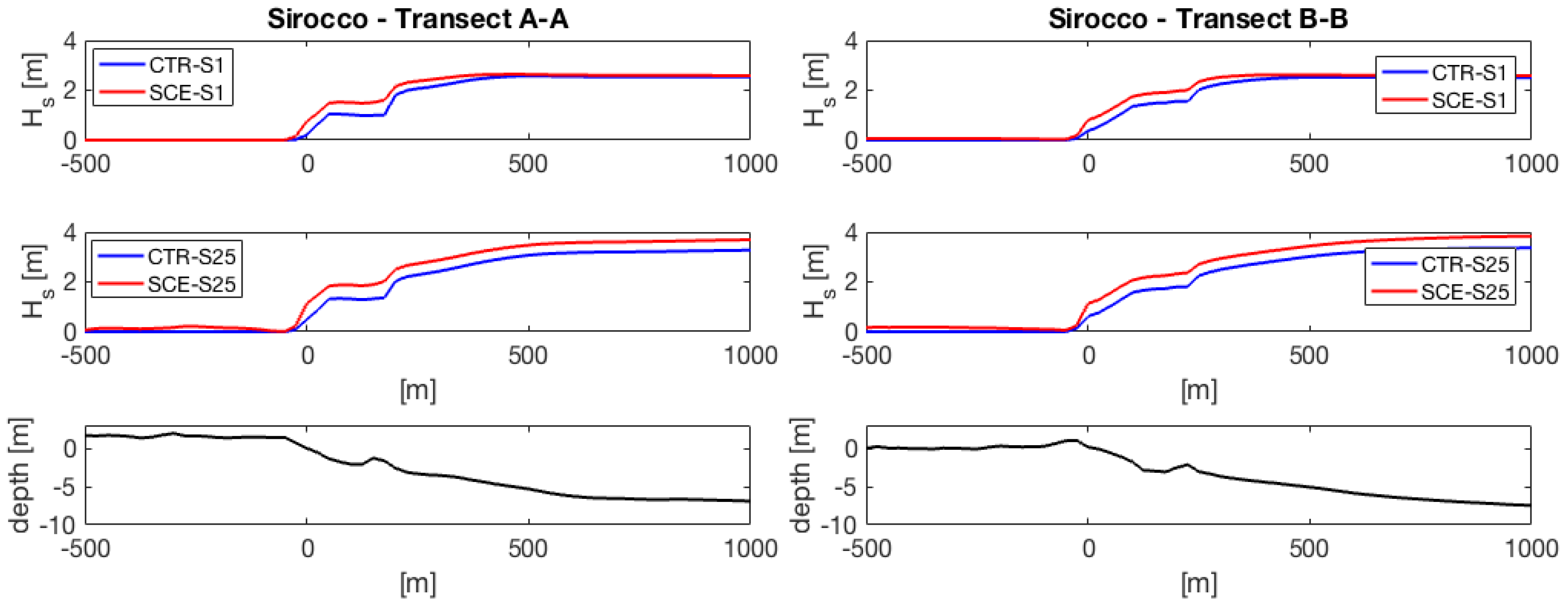

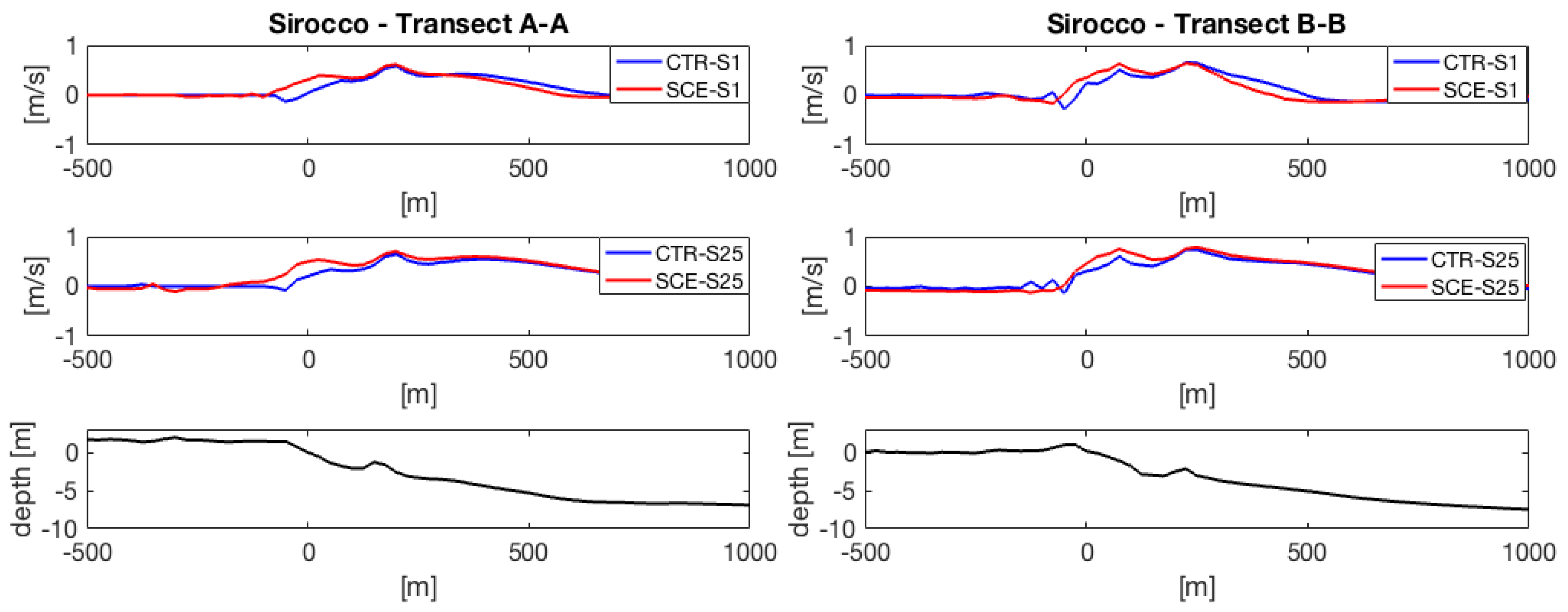

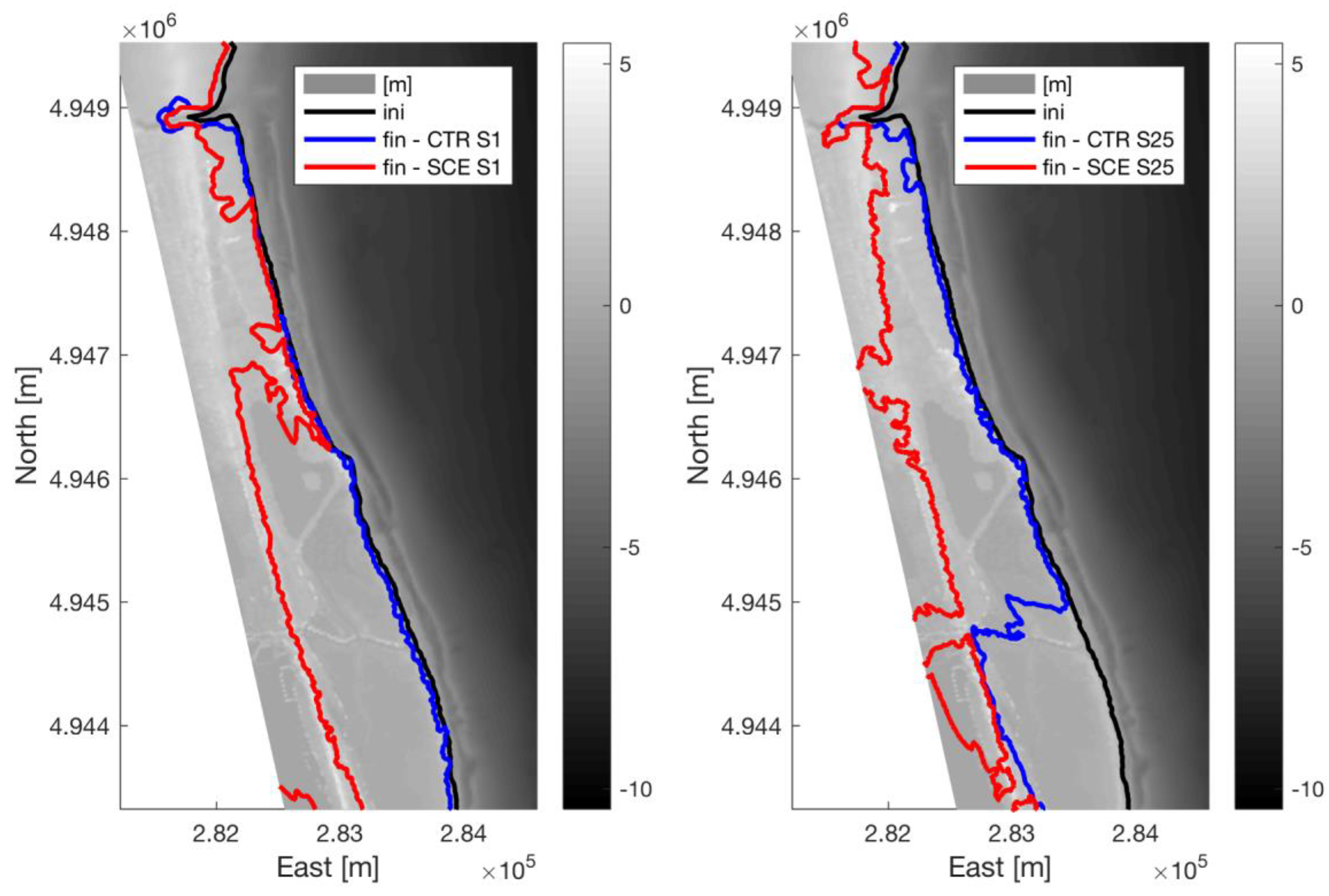
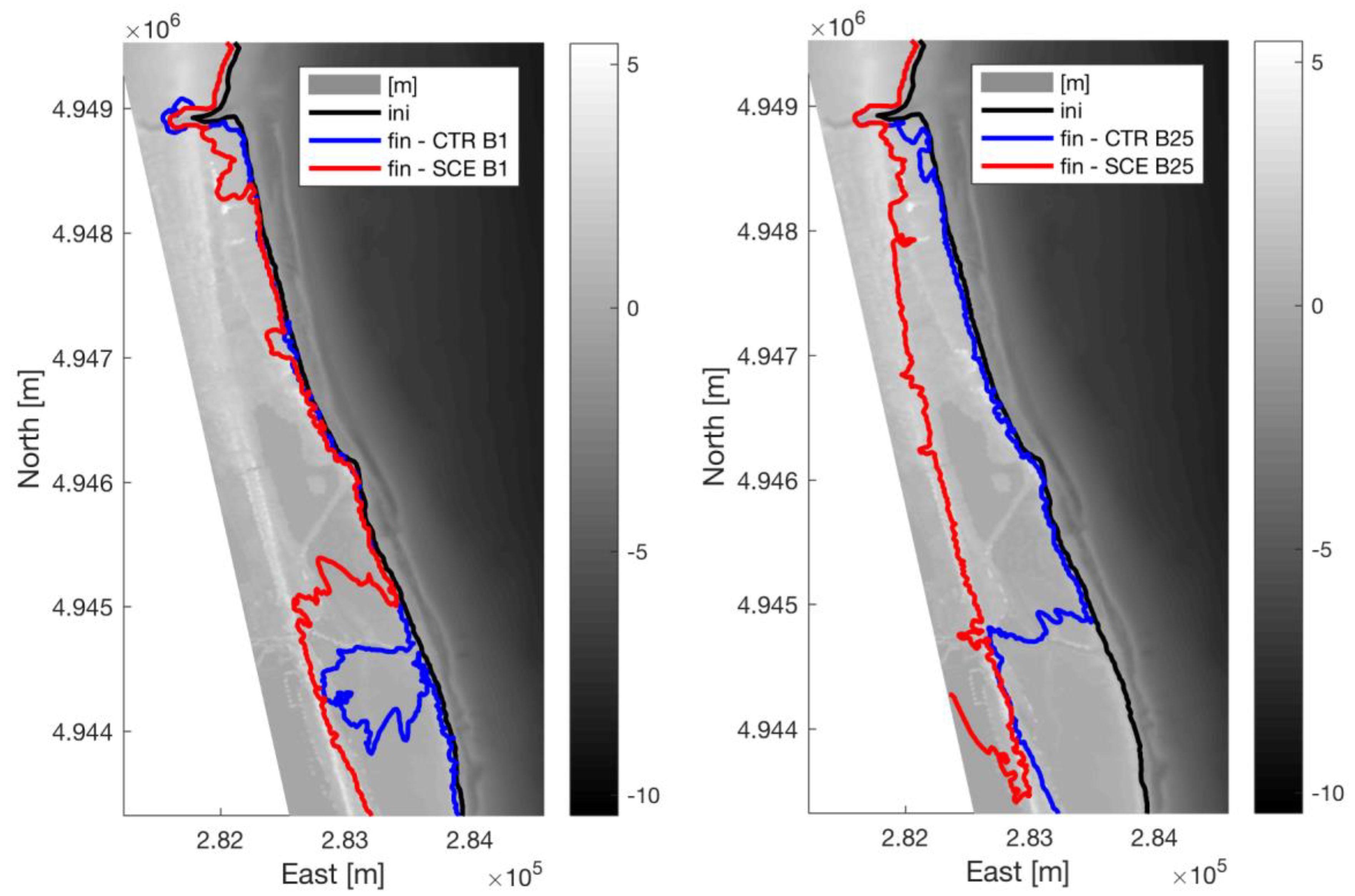
| Chain Level | Model | Extension | Mesh Size Range | Period | Run Type | Forcings |
|---|---|---|---|---|---|---|
| a | RCM COSMO-CLM | Italian marine regions [28] | 0.0715° (~8 km) | 1971–2100 | Atmospheric circulation | SST, atmospheric conditions from [31,32] |
| b | SWAN | Adriatic Sea | 2–10 km | 1971–2000 | Non-stationary wave fields | From (a), wind at 10-m height |
| 2071–2100 | Non-stationary wave fields | |||||
| c | TELEMAC | Lido di Spina (4 km long and 2 km wide) | 25–50 m | 1971–2000 | Stationary wave fields | From (b), after statistics: wave spectra, sea-level rise |
| 2071–2100 | Stationary wave fields |
| Scenario | Period | Storm Direction | Statistics | TR (year) | Run Name | Hs (m) | Tp (1) (s) | Dir (° N) | PWL (2) (m) | SLR (m) |
|---|---|---|---|---|---|---|---|---|---|---|
| CTR | 1971–2000 | Sirocco | Ordinary | 1 | CTR-S1 | 2.50 | 6.56 | 90 | 0.79 | 0.00 |
| Sirocco | Extreme | 25 | CTR-S25 | 3.31 | 7.55 | 90 | 1.05 | 0.00 | ||
| Bora | Ordinary | 1 | CTR-B1 | 2.76 | 6.64 | 45 | 0.83 | 0.00 | ||
| Bora | Extreme | 25 | CTR-B25 | 3.4 | 7.38 | 45 | 1.10 | 0.00 | ||
| SCE | 2071–2100 | Sirocco | Ordinary | 1 | SCE-S1 | 2.57 | 6.65 | 90 | 0.81 | +0.70 |
| Sirocco | Extreme | 25 | SCE-S25 | 3.77 | 8.06 | 90 | 1.18 | +0.70 | ||
| Bora | Ordinary | 1 | SCE-B1 | 2.46 | 6.27 | 45 | 0.79 | +0.70 | ||
| Bora | Extreme | 25 | SCE-B25 | 3.31 | 7.28 | 45 | 1.05 | +0.70 |
| Event | ΔxB (m) | ΔUls, MAX (%) | ΔΩ (-) |
|---|---|---|---|
| Sirocco TR = 1 year | −20 | +2 | 9 |
| Sirocco TR = 25 years | ±0.0 | +8 | 4 |
| Bora TR = 1 year | −200 | −8 | 3.5 |
| Bora TR = 25 years | −70 | ±0 | 3 |
© 2018 by the authors. Licensee MDPI, Basel, Switzerland. This article is an open access article distributed under the terms and conditions of the Creative Commons Attribution (CC BY) license (http://creativecommons.org/licenses/by/4.0/).
Share and Cite
Gaeta, M.G.; Bonaldo, D.; Samaras, A.G.; Carniel, S.; Archetti, R. Coupled Wave-2D Hydrodynamics Modeling at the Reno River Mouth (Italy) under Climate Change Scenarios. Water 2018, 10, 1380. https://doi.org/10.3390/w10101380
Gaeta MG, Bonaldo D, Samaras AG, Carniel S, Archetti R. Coupled Wave-2D Hydrodynamics Modeling at the Reno River Mouth (Italy) under Climate Change Scenarios. Water. 2018; 10(10):1380. https://doi.org/10.3390/w10101380
Chicago/Turabian StyleGaeta, Maria Gabriella, Davide Bonaldo, Achilleas G. Samaras, Sandro Carniel, and Renata Archetti. 2018. "Coupled Wave-2D Hydrodynamics Modeling at the Reno River Mouth (Italy) under Climate Change Scenarios" Water 10, no. 10: 1380. https://doi.org/10.3390/w10101380
APA StyleGaeta, M. G., Bonaldo, D., Samaras, A. G., Carniel, S., & Archetti, R. (2018). Coupled Wave-2D Hydrodynamics Modeling at the Reno River Mouth (Italy) under Climate Change Scenarios. Water, 10(10), 1380. https://doi.org/10.3390/w10101380








